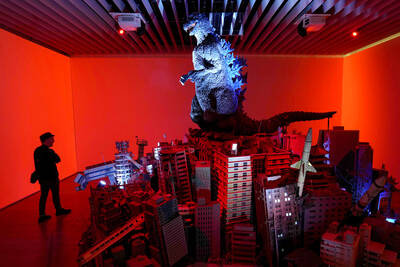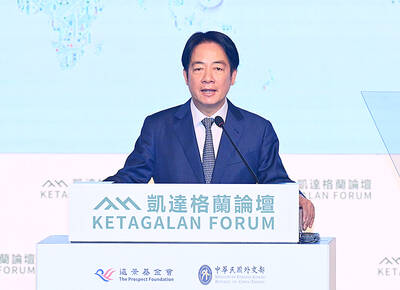Trying to describe Ku & Dancers’ (古舞團) latest production, Decode 2010 (亂碼 2010), is a bit like the old joke about the four blind men and an elephant. Each man grabs hold of a different part of the elephant — its trunk, its tail, a leg and an ear. Each describes what he feels, but the shapes and textures are so at odds that it’s hard to believe they are talking about the same animal.
That’s what Decode 2010 is like. If you talk to someone who saw a different performance, you could describe what you saw and they could describe what they saw and it would be hard to believe it was the same show.
I saw Saturday’s matinee, which was terrific fun, and decided to take founder Ku Ming-shen’s (古名伸) advice and see a second show, to get “the juice” as she put it. Saturday night turned out to be completely different, except it was in the same space (the Experimental Theater), with the same nine dancers, the same multi-talented musician and the last few minutes focused largely on the same male dancer — Ke Te-feng (柯德峰).
The beginning, middle, end and everything in between was different. Actually, in each show at least one dancer got knocked in the head by another’s foot, but it was a different kicker and kickee each time.
The second show was just as good, but it had very different vibe. Perhaps that’s because in the front row of the matinee was a young boy of about four or five; his infectious giggles freed the adults in the audience to laugh out loud as well, while visibly inspiring the dancers. There was also a bit more interaction with the audience in the matinee, whether the front row viewers were ready for it or not.
The 70-minute Decode 2010 was divided into a series of group movements, solos, duets and trios, but the dividing line was not always clear. What was clear was what a talented group of dancers Ku has assembled (including herself): Su An-li (蘇安莉), Christopher Chu (朱星朗), Wang Pei-chun (王珮君), Yu Ming-chu (于明珠), Chang Shu-ching (張淑晶), Yu Yen-gang (余彥芳) and Hsu Cheng-wei (許程崴). Each is a terrific dancer on their own; together they egg each other on and inspire each other to new heights — like climbing up the back wall via the horizontal metal pole that usually serves as a light baton. Ku’s group specializes in Contact Improvisation, and usually they are very good at reading each other, but sometimes you had to wince as a dancer or a pair followed through a movement wherever that might take them — a fall to the floor or a misplaced foot.
As great as the dancers are, Decode 2010 would not have been possible without American Claudia Howard Queen, who spontaneously composed music for the piece in dialogue with the dancers. Sitting amid a grouping of drums, a piano, an electric organ and computer, Queen provided percussion, piano, flute, guitar, vocals and computerized sounds (dripping water, rain, crashing waves, the buzzing of night-time insects) — and at one point in the matinee she played the piano with her left hand while strumming a guitar with her right. It was amazing to watch her — and to watch how she responded to the dancers and they to her, sometimes in harmony, sometimes in contrast.
Queen, who teaches at the University of North Texas and specializes in dance accompaniment, has been in Taiwan twice on Fulbright awards to teach at Taipei National University of the Arts and TaipeIdea, which is how she linked up with Ku. Let’s hope that she can win more grants to come back to Taiwan both to teach and perform.
And lest you put the two shows in one day down to the eccentricity of a reviewer, in the post-performance discussion following the evening show there were at least four other people who had seen more than one show and at least two others at the matinee were overheard planning on attending yesterday’s show.
Who knows, some might even be willing to travel south next weekend when Ku & Dancers perform at the Wei Wu Ying Center of the Arts in Fengshan City.
At the National Concert Hall, the summer jazz series is in full swing, and there were memorable performances this past week by a Latin jazz legend and a brilliant, new-generation American saxophonist.
Cuban pianist Chucho Valdes dazzled a full house last Sunday. The 68-year-old Havana native led his eight-piece ensemble, the Afro-Cuban Messengers, through a two-hour set full of intense, freewheeling jams and steamy grooves.
Valdes is a towering figure among Cuban jazz musicians for his virtuosic technique and an encyclopedic knowledge of classical and modern jazz. And with his imposing physique (he’s almost 196-cm tall), Valdes is also a towering presence on stage.
His long arms seemed to glide about the piano effortlessly, as he played dizzying lyrical runs that floated within the band’s fiercely swinging tempos. Now and again, he would stand up from the piano to play conductor, waving his hands to bring the ensemble down for a smooth landing.
The group, with its powerful three-man percussion section, began with Misa Negra, a composition by Valdes from his early days with the Cuban jazz group Irakere. Vocalist and percussionist Dreiser Durruthy Bambole led the group in a call-and-response that drove the ensemble into an ecstatic frenzy.
They also paid tribute to one of Valdes’ heroes, the late Austrian composer and jazz keyboardist Joe Zawinul, with the funky and upbeat Zawinul’s Mambo. This was followed by a scorching rendition of Birdland, a jazz fusion classic written by Zawinul. When the band finished playing, there was a moment of stunned silence and then wild applause.
The show, which lasted nearly two hours, ended with the crowd-pleasing Besame Mucho, with an impressive vocal performance by Valdes’s sister, Mayra Caridad Valdes, and a final dance number that had the audience on their feet and singing along.
On Friday, there were fewer musicians on stage, but the energy was no less intense. Saxophonist Joshua Redman and his trio played to a nearly full house, performing a 90-minute set of standards and original material.
The 41-year-old American offered a refreshing modern tilt on standards such as the Rogers and Hammerstein tune The Surrey With the Fringe on Top, which was deeply funky. He displayed smooth control on the tenor saxophone on East of the Sun (and West of The Moon), playing clean, fluid lines punctuated by the occasional squall.
These two songs were from Redman’s 2007 album Back East, which provided much of the material for his concert. Redman also performed the quiet and beautiful Zarafah, a ballad composed for his mother.
Redman’s sidemen and frequent collaborators, bassist Matt Penman and drummer Greg Hutchinson, both put on top-notch performances. Hutchinson’s playing draws deeply from 1970s soul and funk influence, which he masterfully combines with his sense of swing. His solo on Identity Thief, from Redman’s latest album Compass, was a good example of this.
The turnout at Redman and Valdes’ concerts are a strong testimony to the popularity of the National Concert Hall’s annual summer jazz series, which started in 2003.
And seeing that Friday’s performance by Brazilian singer Eliane Elias is already sold out, perhaps it’s time for the concert hall to consider making a little more room for jazz artists.

Last week, on the heels of the recall election that turned out so badly for Taiwan, came the news that US President Donald Trump had blocked the transit of President William Lai (賴清德) through the US on his way to Latin America. A few days later the international media reported that in June a scheduled visit by Minister of National Defense Wellington Koo (顧立雄) for high level meetings was canceled by the US after China’s President Xi Jinping (習近平) asked Trump to curb US engagement with Taiwan during a June phone call. The cancellation of Lai’s transit was a gaudy

From Godzilla’s fiery atomic breath to post-apocalyptic anime and harrowing depictions of radiation sickness, the influence of the nuclear bombings of Hiroshima and Nagasaki runs deep in Japanese popular culture. In the 80 years since the World War II attacks, stories of destruction and mutation have been fused with fears around natural disasters and, more recently, the Fukushima crisis. Classic manga and anime series Astro Boy is called “Mighty Atom” in Japanese, while city-leveling explosions loom large in other titles such as Akira, Neon Genesis Evangelion and Attack on Titan. “Living through tremendous pain” and overcoming trauma is a recurrent theme in Japan’s

As last month dawned, the Democratic Progressive Party (DPP) was in a good position. The recall campaigns had strong momentum, polling showed many Chinese Nationalist Party (KMT) lawmakers at risk of recall and even the KMT was bracing for losing seats while facing a tsunami of voter fraud investigations. Polling pointed to some of the recalls being a lock for victory. Though in most districts the majority was against recalling their lawmaker, among voters “definitely” planning to vote, there were double-digit margins in favor of recall in at least five districts, with three districts near or above 20 percent in

The great number of islands that make up the Penghu archipelago make it a fascinating place to come back and explore again and again. On your next trip to Penghu, why not get off the beaten path and explore a lesser-traveled outlying island? Jibei Island (吉貝嶼) in Baisha Township (白沙鄉) is a popular destination for its long white sand beach and water activities. However, three other permanently inhabited islands in the township put a unique spin on the traditional Penghu charm, making them great destinations for the curious tourist: Yuanbeiyu (員貝嶼), Niaoyu (鳥嶼) and Dacangyu (大倉嶼). YUANBEIYU Citou Wharf (岐頭碼頭) connects the mainland